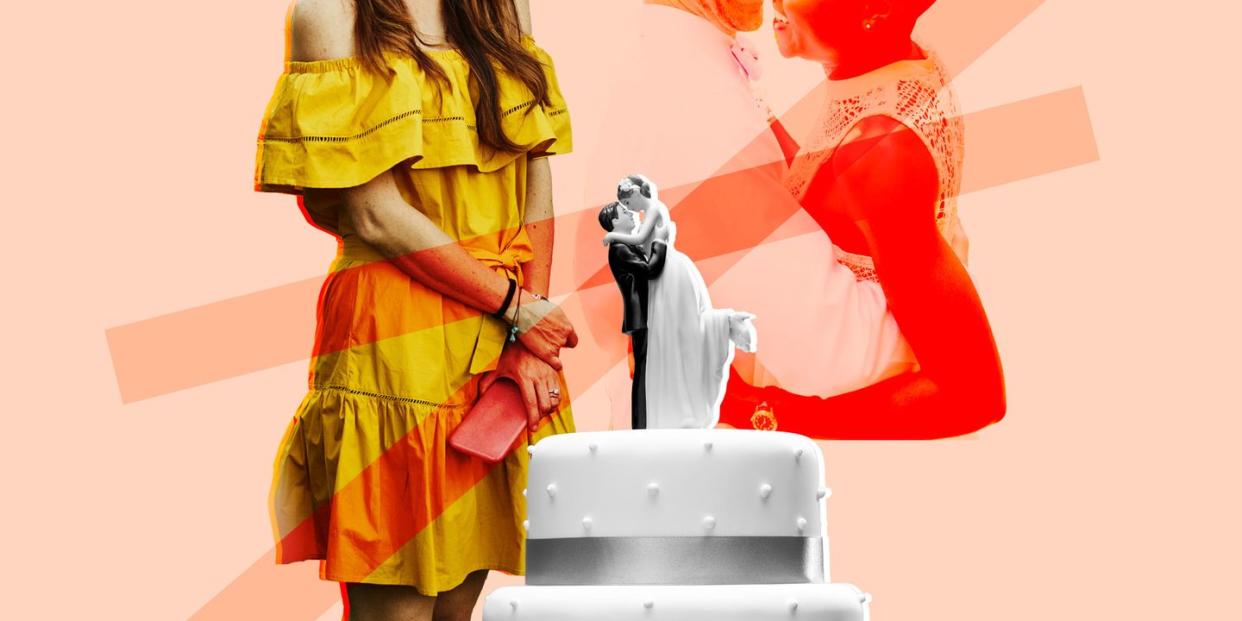Sorry, but Your Made-Up Wedding Dress Code Is Bullsh*t

When I hit “publish” on my wedding website last fall, I immediately got a text from a friend.
“Hi! Excited for your wedding! I love the site! So cute! Btw, it says the dress code is ‘dress fancy,’ but what do you mean by ‘fancy’?” she asked.
I was instantly annoyed. Why can’t you read my mind? I wondered unfairly. My wedding would be in February, it would be late at night, and it would be a heavy dance party with lots of people. Like, dress fancy! You know what that means!
“Tuxes?” she asked.
Well, no, I didn’t want people to wear tuxes, I guess, since my now-husband wouldn’t be wearing one, and I’d heard you’re supposed to be the best-dressed people at your own wedding (makes sense). I didn’t want anyone to show up in khakis, either, but I also didn’t want to write “No khakis!” on my invitation and insult any pro-khaki family or friends (or-gasp!-future in-laws). I just wanted people to...dress fancy.

Now I know that I really should have just stuck to one of the boring, normie dress codes: casual, semiformal, cocktail, black tie optional, or black tie.
But in a world where weddings are increasingly forgoing tradition and becoming unique creations of those declaring “I do,” classic and expected attire instructions are taking a back seat. Instead, more couples (guilty as charged) are favoring seemingly random mishmashes of words in an attempt to make their event feel super special and unique. I mean, I’ve been invited to a “New Year’s Eve Casual” wedding. A friend of mine was once told to wear “California Chic.” (What even is that?)
We have no idea what these made-up dress codes mean...and that’s the problem.
“Having a creative dress code that people aren’t familiar with is a no-no,” says Cara Eswein, owner of Love Pretty, an invitation design company. “Not only will it cause confusion, but people often just won’t follow it.”
Plus, hey brides, telling people they should wear “Garden Black Tie” or “Miami Casual” or “Thanksgiving Island Semiformal” is going to be super annoying for you too. You’ll field questions left and right from guests; I certainly did with my whole “dress fancy” debacle.
Having an ambiguous dress code of your own imagination also means there’s a good chance more than one guest will come wearing something they deemed appropriate for “Colorado Cool” but you think looks heinous. Flannel top and tulle skirt? Get out of my pictures, please.
Instead, Eswein says to choose clear, concise language you can slap on your invites and wedding website that will leave no questions unanswered. Best way to do that? Pick a classic option and stick with it. There’s a reason why the über-traditional wording is still popular. It’s universally understood, and a quick Google search clears up any confusion.
A black tie evening wedding in the winter? There’s a Pinterest board for that-and it’s pointing you in the direction of a gorgeous dark gown. Cocktail attire for a summer afternoon affair? Oh, hey! There’s a Pinterest board for that too, and it wants you to wear your fave floral maxidress.
Now, it seems obvious. But it certainly did not a few months ago when a family member hit me up to ask if her husband should wear a tux. I sighed heavily, gave up, and edited my website to say “Dress fancy-no tuxes.”
('You Might Also Like',)

